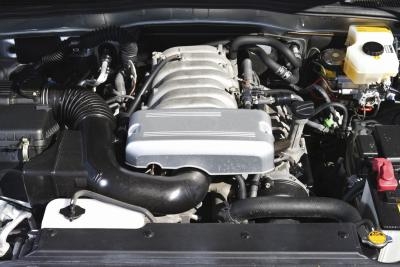
The master cylinder in your Dodge Caravan is responsible for forcing fluid pressure to the four wheels when you apply the brakes. The master cylinder is also the main storage vessel for brake fluid. If the seals inside your master cylinder develop leaks, you will lose brake pressure internally. This could cause problems for the brake booster, as well as causing the brake pedal to sink to the floor when you press the pedal. The master cylinder can be replaced in about 30 minutes.
Press the brake pedal a few times until you have a firm pedal.
Open the hood and prop it up with the hood support rod. Locate the master cylinder, which is mounted to the brake booster on the bulkhead between the engine and passenger compartments, just in front of the driver. Spray the top area of the master cylinder liberally with brake cleaner. Push down lightly on the master cylinder filler tube and turn it counterclockwise to remove it.
Locate the fluid-level sensor connector(s). There may be one or two sensors on your vehicle and they appear as wires, in a plastic housing, plugged into the side of the master cylinder. Remove each connector by depressing the locking clip and pulling straight out from the master cylinder.
Remove the brake lines from the master cylinder by turning the fittings counterclockwise with the flare nut wrench. Gently pull the brake lines away from the master cylinder.
Remove the bolts securing the master cylinder to the brake booster by turning the nuts counterclockwise with a socket and ratchet. Pull the master cylinder straight out, being careful to avoid spilling brake fluid on your vehicle's painted surfaces.
Verify that the rubber O-ring seal is in place on the new master cylinder and then slide the master cylinder in place over the mounting studs. Thread the nuts onto the studs by turning them clockwise. Tighten the nuts to 18 foot-pounds. You may have to hold the booster actuator rod in position as you install the master cylinder.
Fill the master cylinder with new brake fluid and thread the bleeder fittings into the brake line ports by turning them clockwise by hand. Install the rubber tubes onto the fittings and secure the tube ends in the master cylinder filler opening. Make sure the ends of the tubes are completely submerged.
Depress the brake pedal a number of times, slowly and evenly, while a helper watches to ensure that no more air escapes from the bleeder tubes. Remove the bleeder fittings by turning them counterclockwise and carefully set them aside. Reconnect the electrical fittings by firmly pushing straight in until they click.
Thread the brake lines into the proper ports by turning them clockwise by hand. Tighten the fittings to approximately 13 foot-pounds with the flare nut wrench. Have your helper press the brake pedal slowly and evenly five times and then hold it. Slowly crack open the front fitting by turning it a quarter-turn with the flare nut wrench and allow the brake pedal to fall to the floor. Have your helper hold the pedal on the floor as you tighten the fitting. Repeat this process until no more air bubbles appear. Repeat this process on the rear port.
Retighten the fittings to 13 foot-pounds. Install the filler tube by placing it on the filler opening and turning it clockwise. Refill the master cylinder to the "Fill" mark or 1/4-inch from the top.